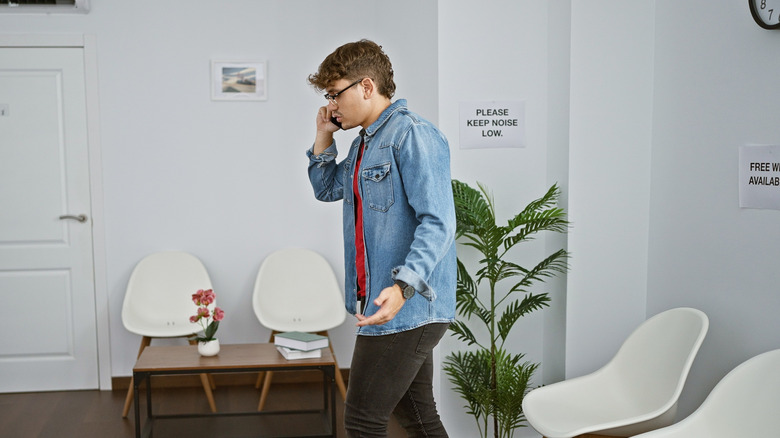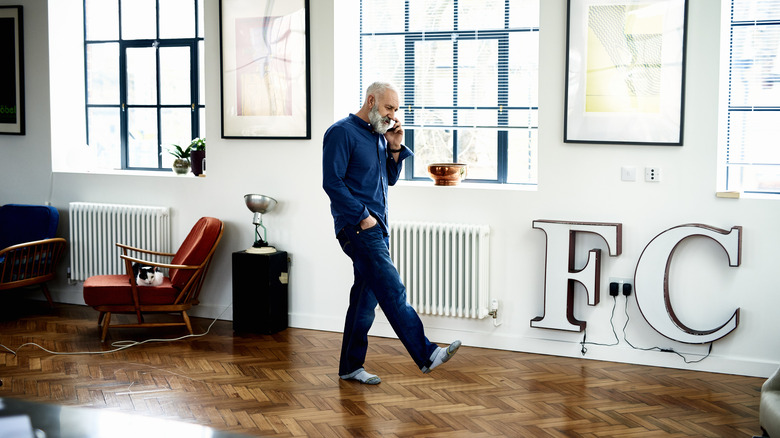What It Means When You Pace Around The House While On A Call
The industrial revolution gave rise to all sorts of world-changing inventions between 1750 and 1900, one of which was the telephone. Independently created by both Alexander Graham Bell (who usually gets all the credit) and Elisha Gray in the 1870s, the telephone revolutionized how people communicated.
Ever since, the phone has gone through some revolutions of its own, to the point where it has now become a ubiquitous handheld device to which we're all addicted. That's something Bell surely never envisioned when he submitted his patent back in 1876, but our current smartphone-addicted culture isn't the only thing that Bell couldn't have foreseen.
He likely didn't foresee Thomas Edison's suggestion of "Hello" as a greeting overshadowing his own suggestion of "Ahoy!" And the inventor likely never imagined that the absence of a physical interlocutor would have us all pacing around while taking our phones. But that's exactly what's happened.
Pacing on the phone comes from a lack of visual stimuli
Even those who aren't the type to pace around while on a phone call have surely witnessed such behavior. Dads, for some reason, are expert phone pacers and we've all surely had that one colleague who can't help but provide a physical accompaniment to their excessively loud conversation. But it turns out that in all these cases, dads and annoying colleagues are having a perfectly normal reaction to the fact that they're speaking to someone who is not physically present.
It stems from the fact that we get a lot of visual feedback when we're talking to someone in person, and transmit a lot of our own meaning through our physical movements. Body language, eye movements, and facial expressions all provide us with visual clues as to how our words are being received and how to interpret what our conversation partner is saying. But they also work in the same way for us, providing ways other than our voice to express what we mean. When all of that is taken away and we're just left with our voice to transmit our feelings and meanings, our minds simply can't handle it. As a result, we tend to transfer the energy that would usually go into these extra conversational factors into physical movement: pacing around.But it's not just that we're making up for a loss of visual stimuli. There is another element at play in the phone pacing phenomenon.
Moving helps us think, especially on phone calls
Walking around while we talk on the phone goes beyond our brains making up for the lack of a physical conversation partner. It also helps us to think more clearly. A study in the Journal of Experimental Psychology detailed four experiments that demonstrated how walking can boost creativity, further emphasizing the known link between physical activity and cognition. It's a significant relationship, too. The researchers in this particular study noted that, for one experiment, the average increase in creative output when walking as opposed to staying still was roughly 60% (interestingly enough, research also shows that drinking beer can increase creativity).
Similarly, another paper from Carolyn Y. Wei at the University of Washington looked at why we might gesture while on a phone call, even though the other person can't see us. Wei noted how the literature suggests people may be "wired" to use gestures when speaking simply for their own benefit as much as the listener's. Also covered in the paper is an experiment which showed that even blind people gesture when they speak, and found no significant differences in the amount or type of gesturing between blind and sighted participants.
Elsewhere, cognitive psychologist Barbara Tversky has carried out experiments that when test subjects who frequently gesticulated while talking were told to sit on their hands, their speech became noticeably less fluent, once again highlighting the important link between physical movement and cognition. Put simply, moving while talking helps us think, even when we're not on the phone. When you throw in the lack of a physical listener, our need to move increases even more, making pacing while on the phone almost inevitable.


